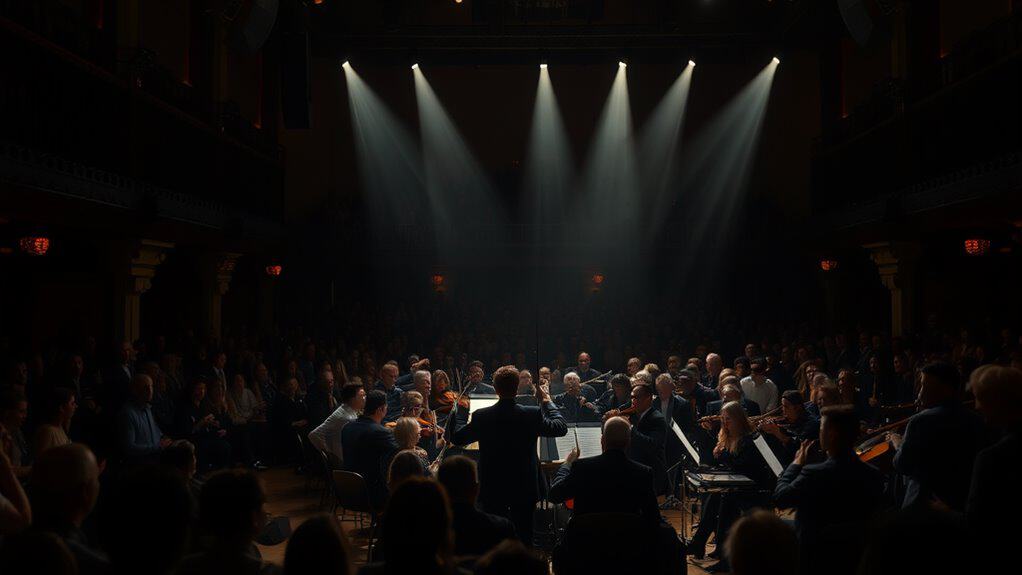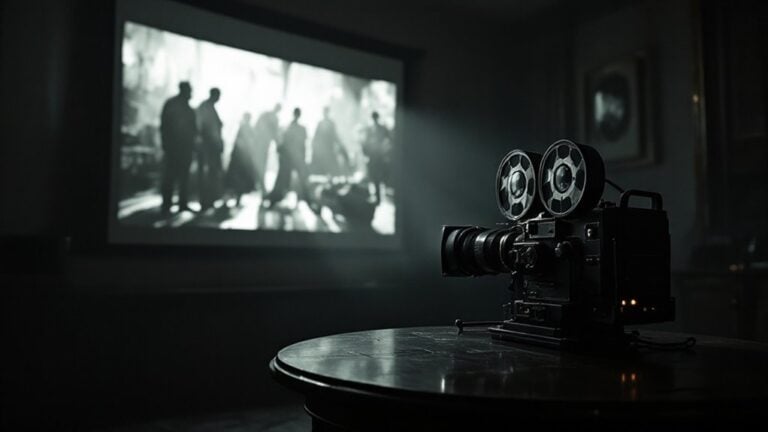Why Interstellar’S Soundtrack Resonates With Audiences Years Later
Interstellar’s soundtrack resonates years later because it masterfully intertwines emotional depth with innovative musical techniques. Hans Zimmer’s score acts as emotional glue, reflecting themes of love and sacrifice that speak to universal experiences. The unique use of a pipe organ and experimental sounds creates an otherworldly atmosphere, propelling the narrative forward. Critical acclaim cements its status as a lasting piece of art, noted for its ability to immerse you in the film’s emotional landscape. Furthermore, its philosophical undertones encourage reflection on existence, ensuring it remains relevant. Explore further to uncover the full impact of this iconic score.
Table of Contents
Key Takeaways
- The emotional depth of the score fosters lasting connections with audiences, reflecting universal themes of love and sacrifice.
- Innovative musical techniques, like the use of a 90-year-old pipe organ, create a unique and mystical soundscape.
- Critical acclaim highlights its ability to enhance narrative flow, making the soundtrack a timeless piece of cinematic art.
- The philosophical themes within the music invite audiences to reflect on existential questions, resonating long after the film ends.
- Zimmer’s orchestration techniques set a new benchmark, inspiring contemporary composers to explore emotional resonance in film scores.
Emotional Connections in the Score
The score of “Interstellar” acts as an emotional glue that binds the film’s events and characters together, enhancing your viewing experience. When you listen, you can feel the emotional themes weaving through the music, creating a profound connection to the character relationships. The four-note motif, inspired by the love Cooper has for his son, resonates deeply, reminding you of the universal ties that bind us. This collaboration between Nolan and Zimmer resulted in a score that brings a unique depth to the storytelling.
It’s not just about the visuals; the score breathes life into moments, emphasizing love, sacrifice, and the quest for belonging. As you journey through the film, you’ll notice how the music complements the narrative, elevating both the awe of space exploration and the tenderness of familial bonds. This is especially evident in how the score engages a 60-person choir to enhance the emotional depth of the score, adding a layer of richness and spirituality. The choice of the Harrison & Harrison organ to create a metaphysical quality emphasizes the connection between scientific endeavors and intimate human experiences.
The interplay between the organ and other instruments punctuates significant scenes, making you acutely aware of the characters’ struggles and triumphs. Each note serves to amplify the emotional weight of their relationships, drawing you further into their world. You become part of their story, feeling their hopes and fears as if they were your own.
This profound emotional connection, fueled by the score, transforms your experience, making it unforgettable and deeply relatable.
Innovative Musical Techniques

Innovative musical techniques play an essential role in shaping the emotional and atmospheric landscape of “Interstellar.” By incorporating a variety of unique instruments and experimental sounds, Hans Zimmer crafted a score that not only complements the film’s narrative but also deepens your connection to its themes.
The use of a 90-year-old pipe organ adds a mystical layer, while woodwind experimentation creates unusual sounds that enhance the film’s cosmic vibe. Zimmer’s incorporation of synthesizers contributes to a futuristic feel, perfectly aligning with the sci-fi elements. Additionally, the score features a 60-voice mixed choir that evokes feelings of alienation and abstraction, mirroring the film’s narrative. The emotional connection between Cooper and his children is emphasized by the score’s ability to evoke time’s relentless passage, enhancing the overall impact of the film.
As you listen, you’ll notice the use of a pedal point, which mirrors the ticking of a clock, emphasizing the film’s exploration of time. The repetitive chord progression in A minor supports the narrative, allowing themes to unfold naturally. Additionally, the score’s key signature, identified as A natural minor, creates a haunting backdrop that enhances the emotional weight of each scene.
Meanwhile, arpeggios inject intensity, enriching the emotional experience. These techniques reflect musical experimentation and thematic development, allowing the score to resonate on multiple levels.
With a rich instrumental ensemble, including strings and a mixed choir, the soundtrack creates atmospheric soundscapes that echo the vastness of space. In this way, Zimmer’s score not only enhances the film but invites you to reflect on your own journey through time and existence.
Critical Reception and Praise

Critical acclaim has surrounded Hans Zimmer’s score for “Interstellar,” highlighting its emotional depth and innovative qualities. Critics have consistently praised his ability to craft a soundscape that not only complements but elevates the film’s narrative. You’ll find that many reviews celebrate Zimmer’s musical genius, showcasing how his work resonates with audiences long after viewing.
- Soundtrack Dreams awarded it a stunning 98/100, emphasizing its emotional resonance.
- The Hollywood Reporter described it as a “soaring, sometimes domineering wall-of-sound score,” capturing the film’s grandeur.
- BBC News praised how the music makes the film feel colossal, immersing you in its vastness.
- Scores of Scores noted the score’s “intellectually impressive” composition, drawing you deeper into the story.
Moreover, Zimmer was inspired by the father-daughter bond central to the film’s narrative, which further enhances the emotional weight of the score. Each review underlines the profound emotional impact of the score, demonstrating how Zimmer’s thematic choices enhance character experiences throughout the film. The score, featuring a 1926 Harrison & Harrison organ, showcases Zimmer’s innovative orchestration techniques, including the use of wind sound effects and church organ, contributing to a unique auditory experience. The music composed to enhance mood, visuals and narrative flow adds to its overall effectiveness in storytelling.
Ultimately, this critical reception solidifies “Interstellar’s” soundtrack as a timeless piece of art, ensuring its lasting legacy in cinema history.
Sound Mixing Controversies

Sound mixing controversies surrounding *Interstellar* highlight the film’s bold approach to audio design, sparking debate among audiences and critics alike. While many viewers appreciate the emotional depth created by its mixing techniques, others struggle with dialogue clarity.
Director Christopher Nolan and sound re-recording mixer Gregg Landaker intentionally crafted the mix to prioritize the overall sonic experience, often at the expense of clear dialogue. This impressionistic approach is quite rare in mainstream cinema, challenging traditional expectations. Filmmakers experienced the film in various theaters to finalize sound design, emphasizing the commitment to their unique audio vision. Additionally, the film’s sound design reflects the chaotic environment of space travel, further enhancing the immersive experience.
However, the issues surrounding dialogue clarity don’t stem solely from *Interstellar*’s choices. Modern filmmaking often prioritizes visual elements, sometimes compromising sound quality. The shift toward naturalistic acting styles can muddle dialogue, making it harder to capture. Furthermore, boom mic placement is often compromised by visual aesthetics, which adds to the challenges of achieving clear audio.
Additionally, evolving technology introduces an overwhelming number of sound tracks, complicating the mixing process.
In this context, the *Interstellar* sound controversy becomes a part of a larger discussion about sound in film. While some audiences might find the heavy reliance on music and sound effects frustrating, others embrace it as a necessary part of the emotional storytelling.
As you engage with these debates, consider how they reflect broader trends in the industry and our collective experience of cinema.
Lasting Impact on Film Music

The *Interstellar* soundtrack has left an indelible mark on the landscape of film music, reshaping how composers approach their craft. Zimmer’s innovative use of the pipe organ and synthesizers not only enhanced the film’s cosmic themes but also sparked a soundtrack evolution that influences today’s cinematic trends. As you listen, you can feel the emotional depth and complexity woven into every note, effectively capturing themes of love, sacrifice, and resilience. Consider these lasting impacts:
- Setting New Standards: Composers now endeavor to match the emotional resonance found in *Interstellar*, especially as they explore thematic approaches that emphasize love and legacy.
- Cultural Icon: The theme “First Step” resonates with audiences and has become synonymous with the film’s legacy.
- Musical Innovation: Zimmer’s unique orchestral arrangements have encouraged experimentation in film scores, particularly through the use of a 1926 Harrison & Harrison organ.
- Philosophical Exploration: The soundtrack pushes boundaries, inviting deeper reflection on time and humanity’s quest.
Conclusion
To sum up, “Interstellar’s” soundtrack lingers in our minds like a haunting melody that echoes through time, inviting us to reflect on our emotions and experiences. Its innovative techniques and emotional depth create a tapestry of sound that resonates with audiences long after viewing. While debates over sound mixing persist, the score’s critical acclaim and lasting impact on film music highlight its significance. Ultimately, the soundtrack serves as a powerful reminder of the profound connections we forge through art.







